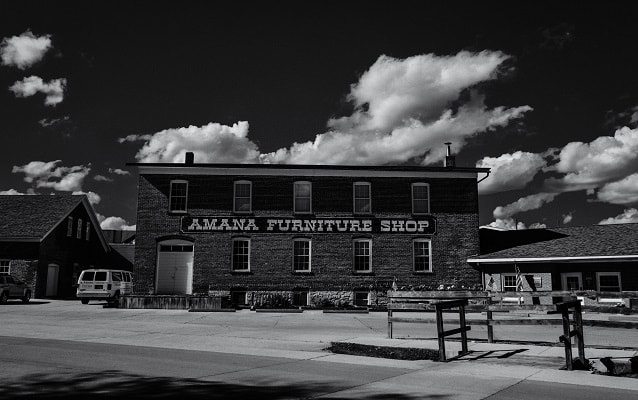Last updated: December 4, 2019
Place
Amana Furniture Shop

Photo by keycmndr (Flickr)
The Amana Furniture Shop occupies the former Calico Mill. Several Inspirationists had been employed in the cloth industry in Germany. They brought their skills, particularly in making calico, with them to the United States. Calico was originally a cotton cloth from India, but came to denote several kinds of cotton cloth. In the United States it usually refers to coarse and printed cloth.
Built in 1861, the Amana Calico Mill grew from one to eight buildings at its height of production in the 1890s. Calico printing was a big industry, and fine white cotton fabric from the south and east coasts was processed here. Fabric was washed, dried, dyed, printed, trimmed, inspected, packed, and shipped. White muslin was acid-proofed and dyed in large vats, then starched and pressed on rollers powered by water from the Mill Race. The factory produced up to 4,500 yards per day at its peak. Railroads running through Homestead and Amana took the material to a national market, which provided a substantial income to the community.
William Rufus Perkins, in his 1891 book History of the Amana Society or Community of True Inspiration, wrote, "The Calico Print Mills were erected in old Amana. They color and print from 3,000 to 4,000 yards daily. The heavy cotton goods are manufactured in the South for the Society. These are called ‘blue print’ and have a good reputation throughout the country."
The factory produced calico for nearly 60 years, until the British naval blockade during World War I interrupted their imports of German dyes. Without the dyes they could no longer produce the quality of product they wanted and the factory closed down.
The two remaining buildings, the fire and printing houses, are used today by the Amana Furniture Shop. They have added on extensively to the east and north of their buildings for work and showroom space. Furniture made in the Amana Colonies continues with the tradition of being individually handcrafted by a skilled artisan. Traditional furniture pieces, such as tables, chests, beds, chairs, and clocks are popular.
